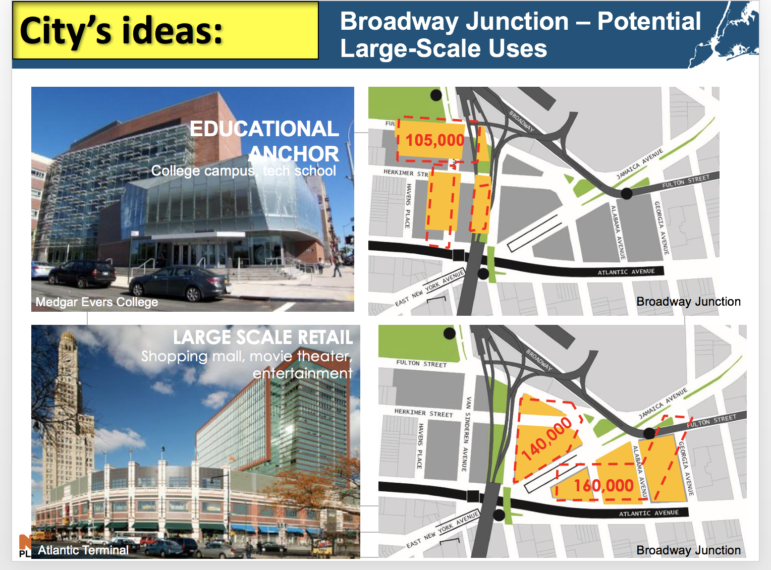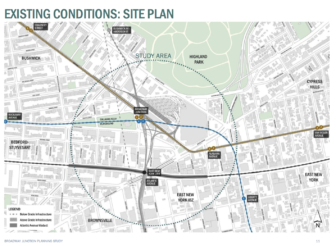
Coalition for Community Advancement: Progress for East New York/Cypress Hills
An image in a slideshow assembled by the Coalition for Community Advancement: Progress for Cypress Hills and East New York. According to The Coalition, the city is contemplating uses like a 4-year-college, large-scale retail, an entertainment complex and government office space.
Last June, City Limits reported that the de Blasio administration was taking steps to catalyze the redevelopment of the area around Broadway Junction, the long-neglected East Brooklyn transit hub. At the encouragement of local officials like Councilmember Rafael Espinal and Borough President Eric Adams, the Economic Development Corporation released a Request for Proposals (RFP) seeking a developer to build a facility for the Human Resource Administration that included space for small businesses. HRA, the thinking was, could serve as an anchor to encourage broader economic development near the transit hub.
In August, however, the Coalition for Community Advancement: Progress for East New York/Cypress Hills, an alliance of neighborhood groups that formed in response to the nearby East New York rezoning, was concerned that residents were being left without a say in the Broadway Junction planning process.
Since then, the Economic Development Corporation has launched an official planning initiative and formed a working group of local stakeholders, including elected officials, representatives of the Coalition and others. The working group has met four times and is expected to meet again twice in the coming months. Meanwhile, the Coalition has begun drafting a list of demands for the area. On Tuesday evening, the group hosted a town hall to gather feedback on those demands from community residents.
No one denies that the transit hub could use investment. But given their disappointment with some of the outcomes of the East New York rezoning process, the Coalition is particularly determined to ensure any redevelopment in Broadway Junction serves community needs. The group has expressed concerns that the East New York plan lacked anti-displacement strategies, that market-rate housing development may take off sooner than hoped, and that the city isn’t doing enough to ensure locals enter career-track jobs in construction, among other issues.
When it comes to the junction, “we’re all about how can we get all the positive amenities and improvements and mitigate any risks of displacement,” said Michelle Neugebauer of Cypress Hills Local Development Corporation, a member of the Coalition. Catherine Green of ARTs East New York said the Coalition hopes “that [when] we go into those coffee shops two years from now, we can still see our neighbors from down the block.”

Coalition for Community Advancement: Progress for East New York/Cypress Hills
An image in a slideshow assembled by the Coalition for Community Advancement: Progress for Cypress Hills and East New York showing the radius of the planning study area.
Showing the audience the study area for the Broadway Junction planning effort, the Coalition said it opposes an area wide-rezoning and wishes to see “incremental development” with only single parcels upzoned one at a time, allowing the community to negotiate community benefits agreements with developers for each project. The Coalition has long expressed concerns that area-wide upzonings, like the East New York rezoning, give too much to developers for too little in return. They also argue that “incremental development” will give the city time to evaluate the impact of each new project on neighborhood displacement.
The Coalition says that given that the East New York rezoning will include new housing, they are opposed to housing construction in the Junction area and instead want to see job-generating commercial and community facilities such as a college, a cultural center, small neighborhood retail, affordable and healthy supermarkets and a credit union. They want no “big box” stores.
The Coalition also set forth a variety of strategies to ensure economic development benefits locals, like requiring developers to set aside affordable space for neighborhood businesses and encouraging them to do their procurement in the neighborhood as well. Anti-displacement policies to protect small businesses, homeowners, tenants, and community facilities are a top priority. The group also seeks improvements to transit, parks, and streetscaping, and an effort to make the transit hub more accessible to people with disabilities.
Attendees at the town hall added their own ideas: Community engagement had to extend to homeless shelters, said one person. The area should also include a Black bank, worker cooperatives, and a community center that employs local residents, others offered. In one break-out session, residents discussed the importance of ensuring there was more technology training in local schools so that local residents could access high-tech jobs. Some residents agreed they’d like to see a supermarket with fresh food, but not a high-end grocery like Whole Foods.
One attendee expressed concern that community benefits agreements are not legally binding. According to the New York Bar, a community benefits agreement between developers and community groups can meet the requirements for a legally binding contract, but enforcing them is typically left to community groups and can be challenging. If the city applied for a rezoning, the community could also negotiate a benefits agreement with the city itself, with the city’s commitments tracked publicly.
Some of those who attended indicated they might be more open to housing. Mitch Vilinsky of DCD Marketing, a marketing and distribution company, said that he owned a warehouse on Broadway near the Junction and that he was having difficulty renting it. He said that if the city rezoned his property he could imagine building a fitness club with housing above. Right now, he said, the Junction has “no opportunity for growth—it’s pretty much a dead space.”
Representatives from the community board and offices of Adams, Espinal, and EDC were present. Andre Mitchell, chair of Community Board 5, said the board’s priority was to ensure the city’s plan is “very close to what the community wanted to have” and will be “benefiting the community more than it is benefiting any other component,” such as developers.
Richard Bearak, director of land use at the Brooklyn Borough President’s office, told City Limits that the city was not looking to rezone that entire half-mile radius study area, and that the extent of any development would be shaped by residents’ visions.
“We are pleased that we are working with the community on a dialogue about what that might look like. But this is not a conversation in which there are any pre-determined outcomes,” said Stefan Ringel, communications director for the Borough President.
The EDC is still evaluating developers to build the commercial space anchored by HRA (coalition members suspect Leser Group, the owners of 2440 Fulton Street, may be frontrunners, and representatives from Leser were present at the town hall). The agency has expressed a desire to site the new office in East New York, but is accepting development applications for other parts of Brooklyn.
The agency also said it was too early to comment on the Coalition’s call for incremental development, that it was still gathering ideas from stakeholders, and that all options are on the table to realize the community’s vision.








3 thoughts on “East New Yorkers Set Forth Visions for Transit Hub Redevelopment”
Exactly what is wrong with our cities and other expensive cities. When housing is treated as a pariah use, you get less of it. When you get less housing, you get higher rents. In places where it is easy to build housing (i.e. middle America) you get lower rents. Why can’t the authors of this blog understand this, instead of parroting Not In My Back Yard rhetoric?
As a long-time resident of the Junction neighborhood, as it is has come to be called, I am surprised at the news of so much occurring without the residents having notice of it. A better effort needs to be made to include the community residents in the notification process, not just the organized stakeholders. As a member of the 1400 Herkimer Block Association, we have an interest in what goes into this plan as it greatly affects us as homeowners and renters.
Big Box stores and large supermarkets like Stop-N-Shop provide a larger selection of items at lower prices than small stores. That’s just the truth of it.